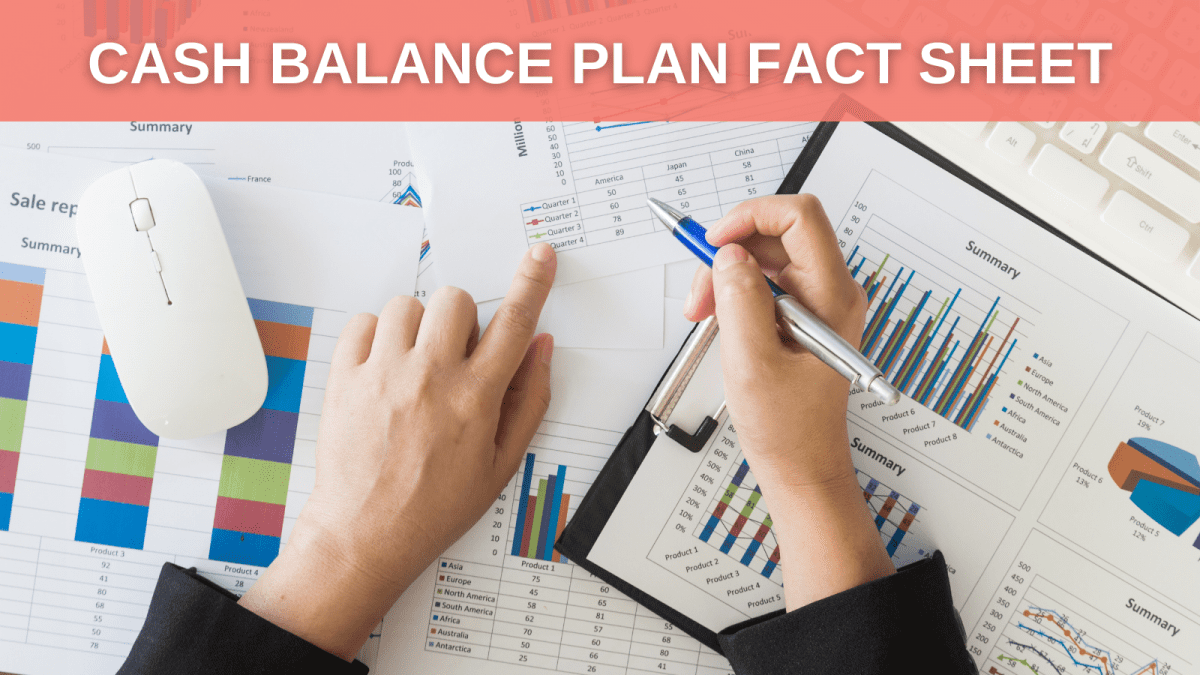


How Soon Are Rate Hikes Coming?
February 28, 2022


What You Should Do When Facing a Bear Market
March 31, 2022A cash balance plan is a qualified (tax-favored) retirement plan that combines the high contribution amounts of a defined benefit plan with the look, feel and portability of a defined contribution plan. For that reason, it’s called a “hybrid” plan.
Cash balance plans resemble 401(k) plans in terms of offering individual, portable retirement accounts. But they allow significantly higher contribution levels and use different investment principles. A cash balance plan communicates the promised benefit to employees as an account balance rather than an annual amount payable for life.
You may want to consider a cash balance plan if…
• You currently sponsor a 401(k) for your company and would like to defer more than $58,000, or $64,500 annually if 50 years of age or older.
• You want to rapidly accelerate retirement savings with annual pre-tax contributions from $100,000 to $200,000 or more, depending on age.
• The owners and executives are, on average, older than the non-highly compensated employees.
• Your 401(k) plan is safe harbor. Companies already making a 3% or higher contribution to staff within an existing retirement plan typically see a great benefit from cash balance.
• You own a family business. A cash balance plan can be used as a component of succession planning.
• The principals or sole proprietors earn more than $150,000 annually.
• Several owners want to benefit from a greatly enhanced retirement plan.
• You need to squeeze 20 years of savings into 10.
• You would like protection from creditors. ERISA protects cash balance plan assets (and assets of all qualified retirement plans) from creditors in the event of bankruptcy or lawsuit.
• You want to attract and retain high-caliber talent.
How much can be contributed in a cash balance plan?
Employer contributions are determined by an actuary and specified in the plan document. It can be a percentage of pay or a flat dollar amount.
What are the advantages of a cash balance plan?
Employer contributions are determined by an actuary and specified in the plan document. It can be a percentage of pay or a flat dollar amount.
1. Reduces taxes. Funds are tax deductible and earnings grow tax-deferred until withdrawn. This benefit is enormous and can have a dramatic impact on savings accumulation.
2. Accelerates retirement savings. Squeeze 20 years of retirement savings into 10.
3. Attracts and retains top talent. Money that would otherwise have gone to the IRS now enriches both the employer and employee retirement savings, helping attract, reward and retain talented tenure employees.
4. Shelter from creditors. In volatile economic times, preserving profits from both taxes and creditors is increasingly important.
5. Protect retirement savings from market volatility. Cash balance plans grow primarily through high contribution amounts earning interest rates that stay ahead of inflation without taking on major risk.
Important Disclosures
This material was created for educational and informational purposes only and is not intended as ERISA, tax, or investment advice. If you are seeking investment advice specific to your needs, such advice services must be obtained on your own separate from this educational material.
All information is believed to be from reliable sources; however LPL Financial makes no representation as to its completeness or accuracy.
This article was prepared by AdviceIQ.
LPL Tracking #1-05247801
Article: CBPCheck
Cash balance plans resemble 401(k) plans in terms of offering individual, portable retirement accounts. But they allow significantly higher contribution levels and use different investment principles. A cash balance plan communicates the promised benefit to employees as an account balance rather than an annual amount payable for life.
You may want to consider a cash balance plan if…
• You currently sponsor a 401(k) for your company and would like to defer more than $58,000, or $64,500 annually if 50 years of age or older.
• You want to rapidly accelerate retirement savings with annual pre-tax contributions from $100,000 to $200,000 or more, depending on age.
• The owners and executives are, on average, older than the non-highly compensated employees.
• Your 401(k) plan is safe harbor. Companies already making a 3% or higher contribution to staff within an existing retirement plan typically see a great benefit from cash balance.
• You own a family business. A cash balance plan can be used as a component of succession planning.
• The principals or sole proprietors earn more than $150,000 annually.
• Several owners want to benefit from a greatly enhanced retirement plan.
• You need to squeeze 20 years of savings into 10.
• You would like protection from creditors. ERISA protects cash balance plan assets (and assets of all qualified retirement plans) from creditors in the event of bankruptcy or lawsuit.
• You want to attract and retain high-caliber talent.
How much can be contributed in a cash balance plan?
Employer contributions are determined by an actuary and specified in the plan document. It can be a percentage of pay or a flat dollar amount.
What are the advantages of a cash balance plan?
Employer contributions are determined by an actuary and specified in the plan document. It can be a percentage of pay or a flat dollar amount.
1. Reduces taxes. Funds are tax deductible and earnings grow tax-deferred until withdrawn. This benefit is enormous and can have a dramatic impact on savings accumulation.
2. Accelerates retirement savings. Squeeze 20 years of retirement savings into 10.
3. Attracts and retains top talent. Money that would otherwise have gone to the IRS now enriches both the employer and employee retirement savings, helping attract, reward and retain talented tenure employees.
4. Shelter from creditors. In volatile economic times, preserving profits from both taxes and creditors is increasingly important.
5. Protect retirement savings from market volatility. Cash balance plans grow primarily through high contribution amounts earning interest rates that stay ahead of inflation without taking on major risk.
Important Disclosures
This material was created for educational and informational purposes only and is not intended as ERISA, tax, or investment advice. If you are seeking investment advice specific to your needs, such advice services must be obtained on your own separate from this educational material.
All information is believed to be from reliable sources; however LPL Financial makes no representation as to its completeness or accuracy.
This article was prepared by AdviceIQ.
LPL Tracking #1-05247801
Article: CBPCheck




